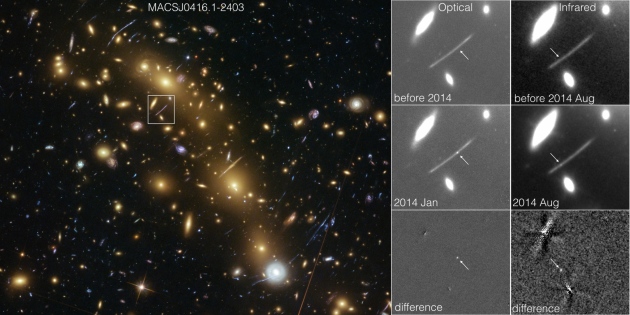Incomprehensible flashes recorded by the Hubble telescope, confused scientists

On the left - observation from January, on the right - from August 2014
On the eve of its 25th anniversary, our beloved Hubble telescope discovered two amazing explosions of stars in the constellation of Eridanus, none of whose properties fit the conventional framework of astronomers. The explosions went out too fast and were too dim for a supernova, but too bright for a new star to appear. The phenomenon was observed twice during 2014, and was presented to the scientific community on April 21 of this year.
Flashes in the night sky, looking like the emergence of new bright stars, can be caused by different phenomena - “new star” or “supernova”. The first variant occurs when in a two-star system a white dwarf pulls the matter of a companion star over itself and explodes as a result. The supernova burns much brighter, briefly eclipsing the entire galaxy when a star explodes, and then gradually extinguished over several months. The causes of the supernova explosion may be a restart of nuclear fusion inside an extinct star or the gravitational collapse of a massive nucleus.
The new phenomenon that the telescope has discovered does not fit into any of these schemes. “The combination of [flare] properties is confusing,” said Mario Livio, an astrophysicist at the Space Research Institute using the space telescope (Baltimore). “I reflected on many possibilities, but any of them does not coincide with all the characteristics of the observed phenomenon.”
')
Telescope-recorded flashes of light came to us from a distance of 7.8 billion light years. It is not yet clear whether this phenomenon, observed in January and August, is the result of the same incident, or whether these were two different cases.
Stephen Rodney, an astronomer from Johns Hopkins University, does not exclude the possibility of observing the so-called. Kilon - a phenomenon that occurs when two supermassive objects collide, for example, neutron stars or black holes. However, this phenomenon occurs so rarely that it is almost impossible to observe it twice a year. Rodney explained that although only a preliminary analysis of the observations has been carried out so far, it is quite possible that astrophysicists will have to change their physical models again.
Source: https://habr.com/ru/post/366911/
All Articles